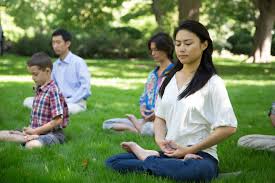 Formal vs. Informal Meditation
Formal vs. Informal Meditation
This post will discuss the difference between formal and informal meditation, and the different nuances within each of those.
Before we start, here’s a metaphor to chew on: the difference between formal and informal meditation is like the difference between “lab science” and “field science.”
One of them is in a special room, with perfect conditions and all sorts of precise tools. The other is out in the messy world, where nothing is controllable. In spite of those obvious differences, at the core, they are both just doing science!
In other words, while formal and informal meditation have clear differences on where/when they’re done, they are actually the same practice—a relaxed awareness of the present moment.
Here are more specific and practical descriptions:
 Formal Meditation
Formal Meditation
This refers to taking a period of time, at least five minutes, where our sole focus is meditation. This is an opportunity to get rid of all external distractions and work directly on our meditation practice.
Usually, it’s done in total physical stillness, like sitting or lying down. However, it could also be done in motion, like walking back and forth, or even activities like Yoga or Qi Gong (assuming we know the routine so well that we don’t have to think about what we’re doing, and can put all our focus on awareness).
A special case of formal meditation is retreat. Here, meditation is our sole focus not just for 20 minutes or an hour, but for a stretch of days. For those who want to really deepen their meditation practice, a classic recommendation is to spend at least a week a year on retreat.
 Informal Meditation
Informal Meditation
This is sometimes called daily life meditation, and it means meditating throughout the day. There are two basic types:
1) Micro-hits. These refer to little spaces, ranging from 5 seconds to 5 minutes, where we take a pause in the day to make meditation our sole focus. It could be while waiting for something, taking a minute before or after a meal, pausing before transitioning to a new activity, or just going into stillness anytime we find we have a few minutes to spare.
2) Background. This is when we are meditating while doing many different activities throughout the day. We could roughly say there are “easy” situations to have a background meditation, like cleaning, cooking or driving; and, there are “difficult” situations to have a background meditation, like socializing, reading or doing computer work.
 The Relationship between Formal Meditation and Informal Meditation
The Relationship between Formal Meditation and Informal Meditation
My teacher, Sayadaw U Tejaniya, entitled his most recent book, “When Awareness Becomes Natural.” What this title suggests is that the more a person does formal meditation, meditating for periods of time each day, and going on occasional retreats, then it becomes easier and easier to do informal meditation.
More specifically, it’s as if our “baseline state of mind” becomes more and more hardwired to meditation. The impulse and desire for micro-hits comes naturally. The background meditation happens all by itself, and it’s not difficult to maintain. It’s as if the momentum of our practice has a life of its own, and it can keep going most of the day.
Remember, even though formal and informal meditation happen in different contexts, and they feed each other, they are actually the exact same thing: a relaxed awareness of the present moment.
Want to try out a 20 second micro hit? Bring your attention to the contact point between your feet and the ground. Feel the body sensations happening there for the next 20 seconds. That’s a micro hit!




